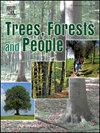Carbon stock dynamics in Ethiopian forests; a systematic review for sustainable forest management towards climate change mitigation
IF 2.7
Q1 FORESTRY
引用次数: 0
Abstract
Forest resources play a role in mitigating climate change; however, effective mitigation requires comprehensive scientific investigation. Numerous studies prove that forests sequester CO2; however, formulating strategies and objectives from disparate evidence is challenging and demands a comprehensive review of recent research. Consequently, we employed PRISMA to investigate the dynamics of Ethiopia's forest carbon pool through the analysis of 113 studies. The studies reveal that 19 optimal allometric equations were developed for different forest scenarios, highlighting the effectiveness of DBH as a predictive variable. Moist montane forests reveal the highest forest carbon pool, measured at 693.1 Mg/ha. Participatory forest management enhances the ability of forests to sequester carbon by 33 % through sustainable practices. The natural forest showed the highest carbon density among various forest types, recorded at 394.58 Mg/ha. Woody biomass carbon stock accounted for the largest portion of biomass at 62.2 %, whereas soil organic carbon comprised 35.6 %. From the included studies we suggest that effective sustainable forest management in Ethiopia calls for the examination of land use changes and the evaluation of diverse forest scenarios to improve forest carbon sequestration capabilities, thus contributing to national and international efforts and commitments of climate change mitigation.
埃塞俄比亚森林碳储量动态;面向减缓气候变化的可持续森林管理的系统审查
森林资源在减缓气候变化方面发挥作用;然而,有效的缓解需要全面的科学调查。许多研究证明,森林可以吸收二氧化碳;然而,从不同的证据中制定战略和目标是具有挑战性的,需要对最近的研究进行全面的审查。因此,我们采用PRISMA通过对113项研究的分析来调查埃塞俄比亚森林碳库的动态。研究结果表明,针对不同的森林情景,建立了19个最优异速生长方程,突出了胸径作为预测变量的有效性。湿润的山地森林显示出最高的森林碳库,测量值为693.1毫克/公顷。参与式森林管理通过可持续做法使森林固碳能力提高33%。天然林的碳密度最高,为394.58 Mg/ha。木质生物量碳储量占总生物量的比重最大,为62.2%,土壤有机碳储量占35.6%。根据所纳入的研究,我们建议,埃塞俄比亚有效的可持续森林管理要求审查土地利用变化和评估各种森林情景,以提高森林固碳能力,从而促进国家和国际减缓气候变化的努力和承诺。
本文章由计算机程序翻译,如有差异,请以英文原文为准。
求助全文
约1分钟内获得全文
求助全文
来源期刊

Trees, Forests and People
Economics, Econometrics and Finance-Economics, Econometrics and Finance (miscellaneous)
CiteScore
4.30
自引率
7.40%
发文量
172
审稿时长
56 days
 求助内容:
求助内容: 应助结果提醒方式:
应助结果提醒方式:


